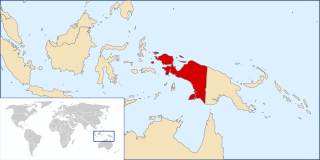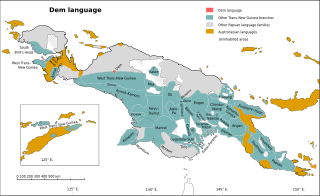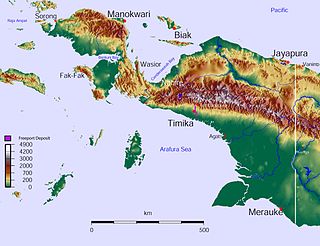
West Papua, formerly Irian Jaya Barat, is an Indonesian province located in the land of Papua. It covers most of the two western peninsulas of the island of New Guinea, the eastern half of the Bird's Head Peninsula and the whole of the Bomberai Peninsula, along with nearby smaller islands. The province is bordered to the north by the Pacific Ocean, to the west by Southwest Papua Province, the Halmahera Sea and the Ceram Sea, to the south by the Banda Sea, and to the east by the province of Central Papua and the Cenderawasih Bay. Manokwari is the province's capital and largest city. With an estimated population of 561,403 in mid-2022, West Papua is the least populous province in Indonesia after Southwest Papua, which was a part of West Papua until separated off in 2022.

Western New Guinea, also known as Papua, Indonesian New Guinea, and Indonesian Papua, is the western, Indonesian half of the island of New Guinea, granted to Indonesia in 1962. Given the island is alternatively named Papua, the region is also called West Papua.

Puncak Trikora is a 4,730 or 4,750-metre-high (15,584 ft) mountain in the Highland Papua province of Indonesia on New Guinea. It lies in the eastern part of the Sudirman (Nassau) Range of the Maoke Mountains.
The Lakes Plain languages are a family of Papuan languages, spoken in the Lakes Plain of Indonesian New Guinea. They are notable for being heavily tonal and for their lack of nasal consonants.
The Paniai Lakes languages, also known as the Wissel Lakes or Wissel Lakes – Kemandoga River, are a small family of closely related Trans–New Guinea languages spoken in the Paniai Lakes region of the highlands of Western New Guinea in the Paniai Lakes region of Papua. Foley (2003) considers their Trans–New Guinea status to be established.

Pistoria is a genus of butterflies in the family Lycaenidae. The single species of this monotypic genus, Pistoria nigropunctata, is found in New Guinea.

New Guinea is the world's second-largest island, with an area of 785,753 km2 (303,381 sq mi). Located in Melanesia in the southwestern Pacific Ocean, the island is separated from Australia by the 150-kilometre wide Torres Strait, though both landmasses lie on the same continental shelf, and were united during episodes of low sea level in the Pleistocene glaciations as the combined landmass of Sahul. Numerous smaller islands are located to the west and east. The island's name was given by Spanish explorer Yñigo Ortiz de Retez during his maritime expedition of 1545 due to the resemblance of the indigenous peoples of the island to those in the African region of Guinea.

The West Trans–New Guinea languages are a suggested linguistic linkage of Papuan languages, not well established as a group, proposed by Malcolm Ross in his 2005 classification of the Trans–New Guinea languages. Ross suspects they are an old dialect continuum, because they share numerous features that have not been traced to a single ancestor using comparative historical linguistics. The internal divisions of the languages are also unclear. William A. Foley considers the TNG identity of the Irian Highlands languages at least to be established.

Dem is a divergent Papuan language of West New Guinea. Although Palmer (2018) leaves it unclassified, it was tentatively included in the Trans–New Guinea family in the classification of Malcolm Ross (2005), and Timothy Usher ties it most closely to Amung.

Operation Trikora was a combined Soviet-Indonesian military operation which aimed to seize and annex the Dutch overseas territory of Netherlands New Guinea in 1961 and 1962. After negotiations, the Netherlands signed the New York Agreement with Indonesia on 15 August 1962, relinquishing control of Western New Guinea to the United Nations.

Taenaris is a genus of butterflies in the family Nymphalidae, subfamily Amathusiinae, that distributed throughout Australasia with a majority of species being located on the island of New Guinea. They are commonly known as the owl butterflies.

Taenaris schoenbergi is a species of butterfly in the family Nymphalidae. It is endemic to New Guinea.

The West New Guinea dispute (1950–1962), also known as the West Irian dispute, was a diplomatic and political conflict between the Netherlands and Indonesia over the territory of Dutch New Guinea. While the Netherlands had ceded sovereignty over most of the Dutch East Indies to Indonesia on 27 December 1949 following an independence struggle, it retained control over its colony on the western half of New Guinea. The Indonesian government claimed this territory as well, on the basis that it had belonged to the Dutch East Indies and that the new Republic of Indonesia was the legitimate successor to the former Dutch colony.

Taenaris myops is a butterfly of the family Nymphalidae.

Taenaris cyclops is a butterfly in the family Nymphalidae. It was described by Otto Staudinger in 1894. It is found in New Guinea in the Australasian realm.

Taenaris artemis is a species of butterfly in the family Nymphalidae. It was first described by Samuel Constantinus Snellen van Vollenhoven in 1860. It is found in the Australasian realm
The East Pauwasi languages are a family of Papuan languages spoken in north-central New Guinea, on both sides of the Indonesia-Papua New Guinea border. They may either form part of a larger Pauwasi language family along with the Western Pauwasi languages, or they could form an independent language family.

The Mamberamo Lakes Plains are a large, flat low-lying area of the Mamberamo River basin in the Indonesian province Papua on the island of New Guinea. The plain is defined by the meandering tributaries of the Mamberamo, and includes hundreds of oxbow lakes. It is 300 kilometers long and about 50 kilometers wide, and is entirely enclosed by mountains apart from the outlet of the Mameramo. It is inhabited in the west, but the eastern lobe is largely uninhabited.

Central Papua, officially the Central Papua Province is an Indonesian province located in the central region of Western New Guinea. It was formally established on 11 November 2022 from the former eight western regencies of the province of Papua. It covers an area of 61,072.92 km2 and had an officially estimated population of 1,430,951 in mid 2022. It is bordered by the Indonesian provinces of West Papua to the west, the province of Papua to the north and northeast, by Highland Papua to the east. and by South Papua to the southeast. The administrative capital is located in Wanggar District in Nabire Regency, although Timika is a larger town.














